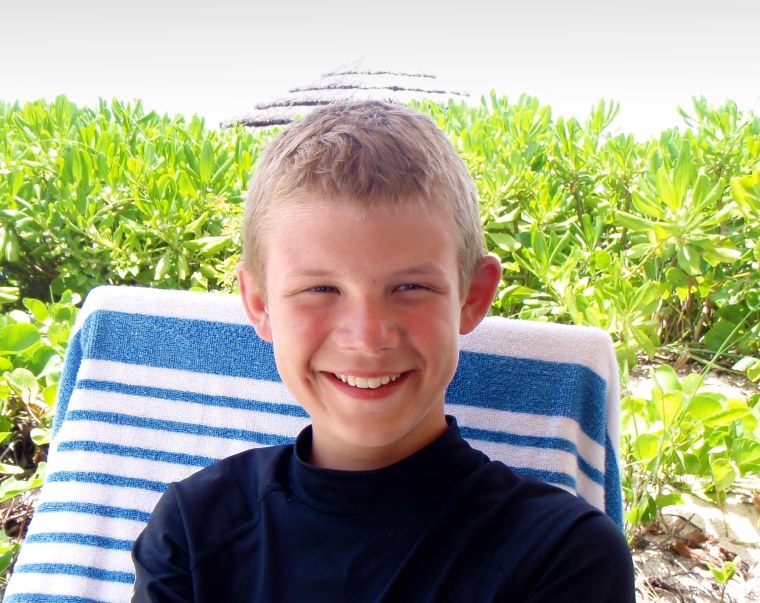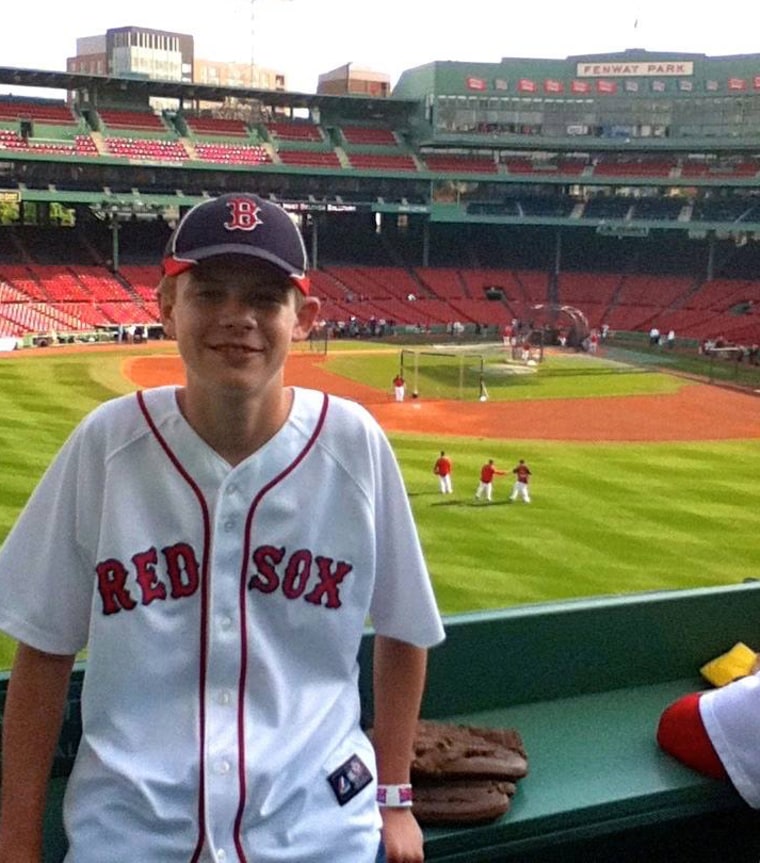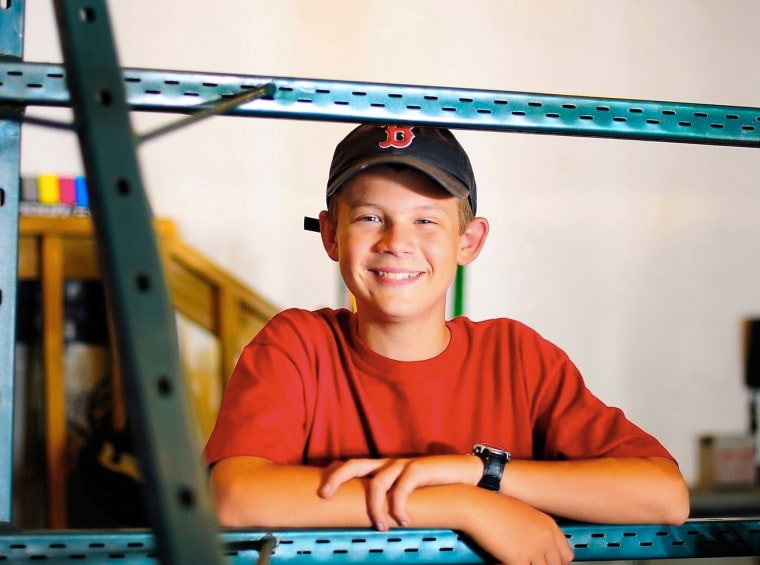At age 14, Connor Ball had seen more of the world than many people could hope to see in a lifetime.
As a perk of his parents’ airline jobs, he got to travel with his family far from their home in Brentwood, New Hampshire, to Europe, South America and Africa.
He loved history and the outdoors, but like millions of teenage boys, he loved baseball more.
And despite his years of globetrotting, his favorite place of all was relatively ordinary: Boston's Fenway Park, just over an hour’s drive away.

“The boy loved the Red Sox,” his mother, Tara Ball, told NBC News. “If you saw him walking down the street, he’d always have a Red Sox hat or jacket.”
Connor was an honor student, a hockey player and an aspiring filmmaker. He had worked on shorts for the New Hampshire Film Festival and was one step away from becoming an Eagle Scout. He had friends and was close to his younger brother.
When he took his own life in the fall of 2011, it was a complete shock.
“Until Oct. 24, 2011, we thought that everything was good with Connor. We had no idea he was suffering from depression,” said Ball. “I’ve had five years to sit and think about it. I have racked my brain trying to understand the reason.”
It’s an agony an increasing number of American families are having to endure.

Between 2007 and 2014, the suicide rate among U.S. middle school-aged kids doubled, according research published last month by the Centers for Disease Control and Prevention.
Not only had the number of suicides among 10- to 14-year-olds reached an all-time high in 2014, the most recent year for which data is available; but the CDC also found that for the first time, more kids in that age range had died by suicide than by car accidents.
Related: Depression Worsening in Teens, Especially Girls
Researchers hope the latest data will call attention to the growing public health problem.
“Most people think there are just a handful of suicides in this age group a year, but the number is perhaps larger than people realize,” Sally Curtin, an expert at the CDC’s National Center for Health Statistics who analyzed the data, told NBC News. “When you compare it to motor vehicle traffic deaths, it gives people a frame of reference, a way to think about it.”
The data alone, while illuminating, leaves much unanswered — chiefly, why an increasing number of children are taking their own lives, and what needs to be done to stop it. The CDC did not attempt to identify reasons behind the spike in suicide rates among America’s youth. Yet experts who work in the field point to a variety of potential factors — including depression, substance abuse and bullying. Many suspect social media also plays a role.
“We certainly know there have been cultural changes, including social media,” said Dr. John Draper, director of the National Suicide Prevention Lifeline, a network of crisis centers that provides a 24-hour hotline for people at risk of self harm.
With social media, he explained, “there could be more cyberbullying, more public humiliation, things that add up to an increasing sense of despair among youth.”
Clark Flatt, founder The Jason Foundation, a Tennessee-based nonprofit specializing in youth suicide prevention, spoke to a similar effect of social media.
“When I was in high school, if I was bullied it had to be from 8 a.m. to 4:30 p.m.,” he said. “Bullying now can basically go on 24/7. I think that adds tremendous pressure to a young person.”
Yet it’s not as simple as pinning the youth suicide surge entirely on social media. Suicide rates have been on the rise in the U.S. since 1999, affecting both men and women in nearly every age category, and experts insist the underlying causes are more complex.
For example, it's possible that rising divorce rates and economic despair may be contributing to the overall increase in suicide, which hit a 30-year high in 2014.
Experts are also quick to stress that, compared to other age groups, suicide is rare among 10 to 14-year-olds.
In 2014, the CDC determined that the number of children in that age bracket who died by suicide came out to 425. By contrast, the number of people between the ages of 45 and 64 who died by suicide that year hit 16,294, according to research published in April by the CDC.
Nevertheless, the spike in youth suicides is alarming — especially when compared to the number of deaths from car accidents. In 1999, the CDC found that the mortality rate of children between the ages of 10 and 14 who died in car crashes was about four times higher than the rate of death by suicide. Over the next 15 years, the death rate for car accidents declined 58 percent, while the death rate for suicide fluctuated and then doubled between 2007 and 2014.
“Any time you see a doubling like that it’s noteworthy,” said the CDC’s Curtin. “It behooves all of us to try and figure out what’s going on here and nip it in the bud before the rate goes even higher.”
With only 425 suicides among 10 to 14-year-olds, it’s difficult to draw conclusions about which demographics are most affected, as researchers require larger numbers to make statistically significant findings. In general, said Curtin, rural areas see more suicides than urban areas, where there tend to be a greater number of mental health and suicide prevention resources. Additionally, Curtin’s research shows that while more boys die by suicide than girls, the rate among girls is rapidly rising. Between 1999 and 2014, the number of girls between the ages of 10 and 14 who died by suicide tripled from 50 to 150.
Some see the data as a major wake-up call for greater state and federal investments in suicide prevention. The Garrett Lee Smith Memorial Act, which was enacted by Congress in 2004, allocates millions of dollars worth of grants to states and tribal communities for suicide prevention and early intervention programs.
But the amount of federal funding for that effort pales in comparison to what the government has invested in safe driving. In 2015, the National Highway and Traffic Safety Administration funded over $576 million in grants to promote motor vehicle safety, according to the National Action Alliance for Suicide Prevention, while the U.S. Substance Abuse and Mental Health Services Administration (SAMHSA) funded approximately $60 million in grants for suicide prevention programming.
“Motor vehicle prevention safety is ten times what we spend on suicide prevention,” said Draper of the National Suicide Prevention Lifeline. “We refer to the reduction in motor vehicle accident deaths as the public health achievement of the 20th century. If we can make a similar kind of investment in protecting families from suicide, it can be the great public health achievement of the 21st century.”

Municipalities, schools and individual families also have an important role to play in terms of investing in training for teachers and students to be able to spot the warning signs and find proper help before a suicide attempt, experts say. There are a number of curriculum-based, peer-to-peer prevention programs — such as SOS Signs of Suicide — that SAMHSA has determined to have “evidence of effectiveness” at decreasing suicides and suicide attempts in middle and high school. But Meghan Diamon, youth programs manager of SOS, says many schools are unaware such courses even exist.
“We don't find funding to be the main barrier to suicide prevention,” said Diamon in an email. “Many schools may not realize that this type of program is available to them because the stigma around mental health and suicide keeps many people from talking about the issue.“
For Ball, who has spent the last half-decade searching for reasons that can help explain the unexplainable, it may never become clear whether her son showed warning signs that could have been detected.
He wasn’t active on social media, she said, and wasn’t bullied at the time of his death. From time to time he would get very angry at the dinner table talking about something as commonplace as politics, but she insists it wasn’t anything adolescent moodiness couldn’t explain.
Still, her non-profit, Connor’s Climb Foundation, works to provide the SOS program to New Hampshire schools, free of charge.
Earlier this month, her son’s former school — Exeter High, which saw two other suicides in addition to her son’s between 2010 and 2012 — began incorporating the program into its 10th grade health class.
“My heart is broken,” she said. “That’s why this is important to me.”
